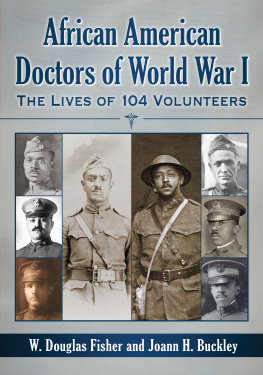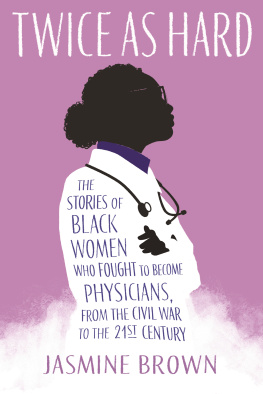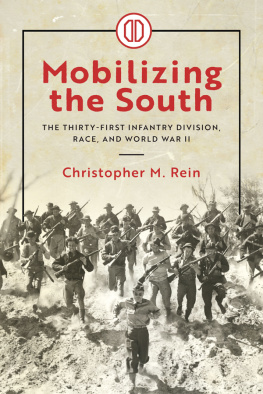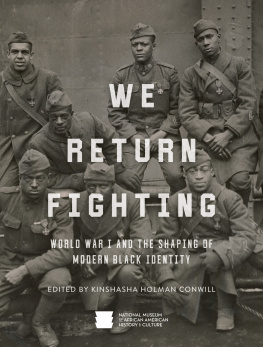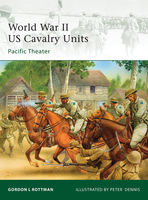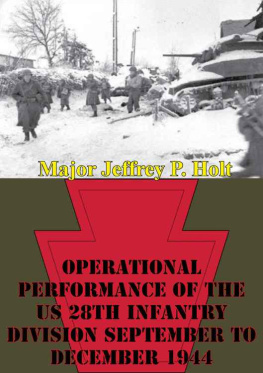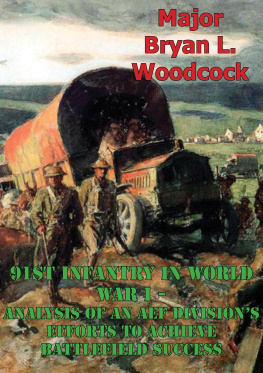
African American Doctors of World War I
The Lives of 104 Volunteers
W. DOUGLAS FISHER and
JOANN H. BUCKLEY

McFarland & Company, Inc., Publishers
Jefferson, North Carolina
LIBRARY OF CONGRESS CATALOGUING DATA ARE AVAILABLE
BRITISH LIBRARY CATALOGUING DATA ARE AVAILABLE
e-ISBN: 978-1-4766-2317-7
2016 W. Douglas Fisher and Joann H. Buckley. All rights reserved
No part of this book may be reproduced or transmitted in any form or by any means, electronic or mechanical, including photocopying or recording, or by any information storage and retrieval system, without permission in writing from the publisher.
On the cover: counterclockwise from top left Capt. James L. Leach (courtesy Meharry Medical College Archives); Capt. John Q. Taylor (courtesy University of Texas at San Antonio Libraries Special Collections); Lieut. Jonathan N. Rucker (courtesy Rucker family); Lieut. William H. Dyer (courtesy Schomburg Center for Research in Black Culture, The New York Public Library, Astor, Lenox and Tilden Foundations); Lieut. Urbane F. Bass in France (courtesy U.S. National Library of Medicine); Capt. T.E. Jones (Whos Who in Colored America, Yenser, Sixth Edition, 19401944); Lieut. George I. Lythcott (courtesy Michael J. Lythcott); Maj. Joseph H. Ward (Scotts Official History of the American Negro in the World War, Emmett J. Scott, 1919)
McFarland & Company, Inc., Publishers
Box 611, Jefferson, North Carolina 28640
www.mcfarlandpub.com
ACKNOWLEDGMENTS
The help and encouragement the authors received over the years from total strangers is remarkable. Librarians, archivists, historians, genealogists, curators, family members, and physicians at research centers, archives, museums, historical societies, universities and other special collections provided invaluable help and guidance.
The Ruckers welcomed us to their family and spent many hours talking about their father. Michael Lythcott wrote the account of his Lythcott grandfather and got us started on the research about his Wilson grandfather. We met with Ballards son and grandson to learn more about him. All gave generously of their time.
Many members of the World War I Historical Association have provided encouragement. The Fort Des Moines Museum and Education Center had us there twice to share our research.
Wilma Moore at the Indiana Historical Society gave us our first opportunity to publish our biographies in Indianas Traces magazine. Her support emboldened us to approach Henry Louis Gates, Jr., who then invited us to contribute 15 biographies to the African American National Biography. That led us to decide we could and should profile all 104 men.
And, special thanks to Kayle Tucker Simon for patiently proofing, editing and polishing our work.
Researching the book has been an exhilarating journey of discovery. We have met amazing people and learned many remarkable things. We are pleased to share them with our readers and look forward to our readers sharing more about these extraordinary men with us.
PREFACE
During the First World War, author Doug Fishers grandfather, Captain John North Douglas, commanded the 317th Motor Supply Train of the 92nd Division, a black combat unit. In his diary and reports he wrote about Dr. Jonathan N. Rucker, an African American physician who cared for his 500 troops. For years Fishers focus was on getting to know Dr. Rucker. What the man was able to accomplish in the Jim Crow South was extraordinary.
In 2010, co-author Joann Buckley became involved. Her initial contribution was to begin the search for other African American physicians who must have served with the 92nd and 93rd divisions. No one, including the curator of the Fort Des Moines Museum where the physicians received their basic military training, knew their names or even how many there were.
After months of combing through files in the National Archives, Buckley discovered the list. It was in an ancient folder of the U.S. Army Surgeon General records. It was so old that its identification tab had disintegrated. It was typed by some clerk a hundred years ago on many sheets of paper and then, because there were so many columns of information on the backgrounds of these 104 physicians, their hometowns, medical schools, graduation years, and ages, the sheets were glued together to make a kind of a display piece. The resulting document was four feet long and 18 inches wide. It was virtually hidden because it had been folded inward on itself several times to make it fit into the otherwise unidentified folder. Once opened, it was so fragile that it nearly blew totally apart at the seams on the first attempt by the Archives staff to copy it.
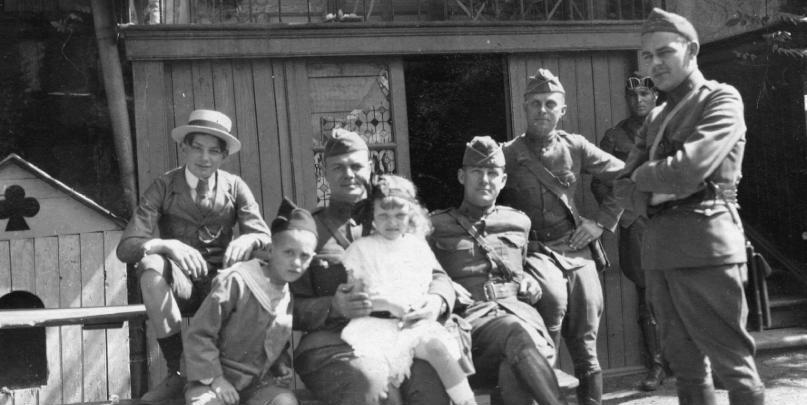
This carte postale shows two unidentified boys at left in August 1918 with Major Fred Carruthers, Little Suzanne (the little girl in his lap), Captain John N. Douglas, Lieutenant Fred Wilmont, Lieutenant J.N. Rucker and Lieutenant Parker of the 317th Supply Train, 92nd Division (W. Douglas Fisher collection).
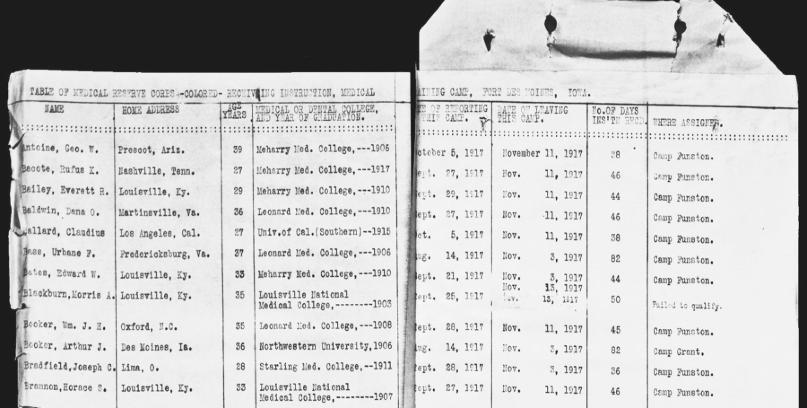
A small portion of the list, 1917 Medical Officers Training Camp roster (National Archives).
So now the quest began for information about each of these men. The two authors spent the next five years in the files at the National Archives, at numerous state and city historical associations, libraries and archives, and utilized a variety of online sources of newspaper articles. The authors also interviewed a number of the children and grandchildren of these extraordinary men.
Initially the authors shared their information in articles in historical journals and magazines like Indianas Traces. Then, after a chance meeting with Professor Henry Louis Gates, Jr., in the elevator of the Hay Adams Hotel in Washington, D.C., and a brief chat about the project, several biographies were included in his African American National Biography. Through the course of development, the authors have shared some of these biographies with historians and the African American community. Following their PowerPoint presentations, they would hear comments like the one by retired African American three-star general Lieutenant General Earl Brown, USAF, This is my history and I knew nothing about it.
The book begins with the doctors gathered together at the only Medical Officers Training Camp (Colored) in U.S. history. It then presents a chronicle of this period in African American history through their individual biographies. The authors approach was to gather individual biographies to help illuminate significant events, challenges and the times at the end of the 19th century and the first half of the 20th. The goal is to provide more depth than a biographical dictionary and more color than an historical narrative, by using illustrative examples. By reading through this series of biographies, the authors believe the reader can gain a firsthand appreciation of a critical piece of American history through the lives of these African American doctors who fought for the nation and their communities.
Next page
